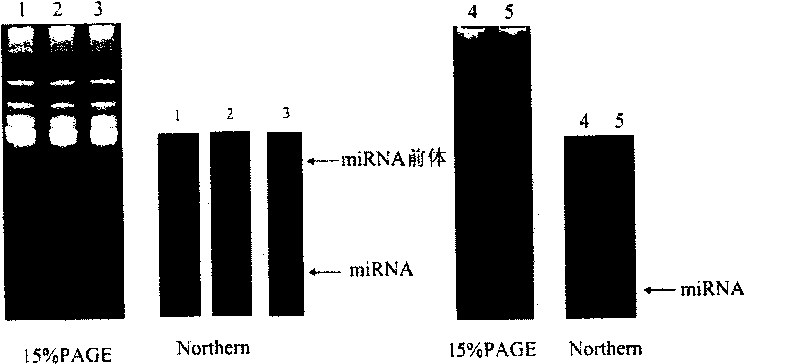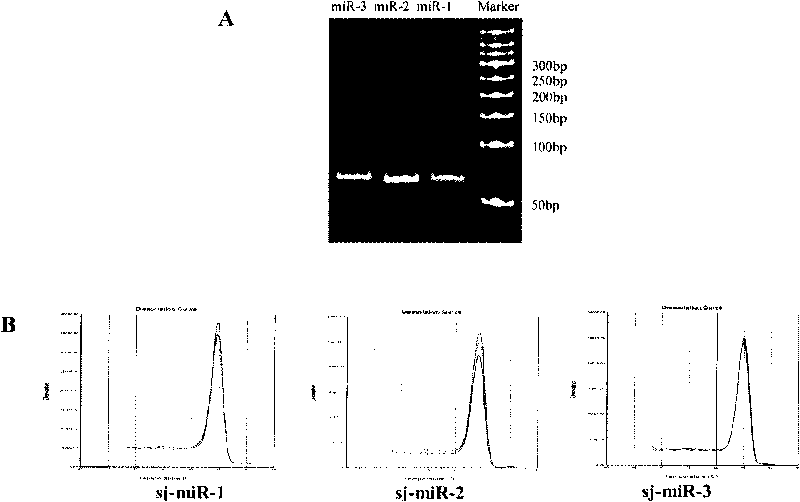Japanese blood fluke miRNAs and applications thereof
A technology for schistosomiasis, sequence, applied in the fields of biomedicine and parasites
- Summary
- Abstract
- Description
- Claims
- Application Information
AI Technical Summary
Problems solved by technology
Method used
Image
Examples
preparation example Construction
[0085] The preparation of the miRNA chip can adopt conventional manufacturing methods of biochips known in the art. For example, if the solid phase carrier is a modified glass slide or silicon wafer, and the 5' end of the probe contains amino-modified poly dT strings, the oligonucleotide probe can be formulated into a solution, and then spotted with a spotting instrument. The miRNA chip of the present invention can be obtained by arranging in a predetermined sequence or array on a modified glass slide or a silicon chip, and then fixing it by standing overnight. If the nucleic acid does not contain amino modification, its preparation method can also refer to: "Gene Diagnosis Technology-Non-radioactive Operation Manual" edited by Wang Shenwu; J.L.erisi, V.R.Iyer, P.O.BROWN. Exploring the metabolic and genetic control of gene expression on a genomic scale. Science, 1997; 278: 680 and Ma Liren, edited by Jiang Zhonghua. Biochip. Beijing: Chemical Industry Press, 2000, 1-130.
[0...
Embodiment 1
[0090] Example 1. Isolation and purification of Schistosoma japonicum small RNA
[0091] The cercariae of Schistosoma japonicum were infected with experimental animals (New Zealand white rabbits or Kunming rats) by patches, and the animals were dissected after 42 days to obtain adults.
[0092] Adult samples of Schistosoma japonicum were ground into powder with liquid nitrogen, and total RNA was extracted with Trizol (Invitrogen). Treat the water with DEPC to adjust the concentration of non-degraded total RNA to 1mg / ml, add NaCl and 5% PEG8000 with a final concentration of 0.5M, mix well, precipitate at room temperature for 10min, 12000rpm, 4°C, 15min, take the supernatant, add 2.5 Double the volume of absolute ethanol, mix well, and precipitate at -20°C for more than 2 hours. Then 13000rpm, 4°C, 30min. The supernatant was discarded, and the precipitate was dried at room temperature for 5 min. Add an appropriate amount of DEPC-treated water or formamide to dissolve RNA, mea...
Embodiment 2
[0093] Example 2. Construction of a cDNA library for small RNAs
[0094] Use 15% urea denatured PAGE gel to recover small RNAs of 18-26 nt, respectively use T4 RNA ligase (MBI) to add 3'-linker 5'-p acuGTAGGCACCATCAA (SEQ ID NO: 16) p-3' and 5'-linker 5'-ATCGTaggcaccugaaa-3' (SEQ ID NO: 17) (wherein, lowercase is RNA, uppercase is DNA, p refers to phosphate group), then use RT primer (5'-ATTGATGGTGCCTAC-3' (SEQ IDNO: 18) ) to reverse transcribe the adapter-added small RNA to obtain cDNA. PCR primers (5' primer: 5'-ATCGTAGGCACCTGAAA-3' (SEQ ID NO: 19), 3' primer: 5'-ATTGATGGTGCCTACAG-3' (SEQ ID NO: 20)) were designed according to the RT primer and the RNA linker. The obtained cDNA was used as a template for PCR amplification, and the PCR product was digested with BshN I (MBI), ligated to itself, filled in again, connected to the T vector pMD18-T plasmid (Takara), screened positive clones by PCR, and sequenced.
PUM
 Login to View More
Login to View More Abstract
Description
Claims
Application Information
 Login to View More
Login to View More - R&D
- Intellectual Property
- Life Sciences
- Materials
- Tech Scout
- Unparalleled Data Quality
- Higher Quality Content
- 60% Fewer Hallucinations
Browse by: Latest US Patents, China's latest patents, Technical Efficacy Thesaurus, Application Domain, Technology Topic, Popular Technical Reports.
© 2025 PatSnap. All rights reserved.Legal|Privacy policy|Modern Slavery Act Transparency Statement|Sitemap|About US| Contact US: help@patsnap.com



